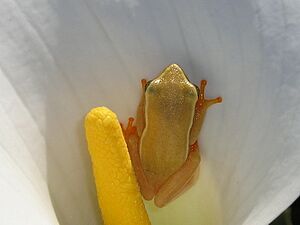Arum frog facts for kids
Quick facts for kids Arum lily reed frog |
|
|---|---|
 |
|
| Conservation status | |
| Scientific classification | |
| Synonyms | |
|
Hyla horstockii Schlegel, 1837 |
The arum lily reed frog, also called Horstock's arum-frog or Horstock's reed frog (scientific name: Hyperolius horstockii), is a type of frog. It belongs to the Hyperoliidae family. This special frog lives only in South Africa.
What Does the Arum Lily Reed Frog Look Like?
Adult arum lily reed frogs can grow up to 40 millimeters (about 1.5 inches) long. They have bright orange feet. These frogs are amazing at changing their skin color. This helps them blend in with their surroundings.
The top of their body is usually cream or brown. Sometimes, they have small black spots. A clear, pale line runs from their nose along their sides. Below this pale line is a dark brown band. A thin, dark line often separates these two bands.
The hidden parts of their legs, the webbing between their toes, and their toe pads are orange to red. Their belly is creamy white and feels a bit bumpy. Male frogs have a bright yellow-orange throat flap. Their eyes have pupils that are shaped like a horizontal line.
Young arum lily reed frogs, called tadpoles, can also reach 40 millimeters in length. They are brown and have darker stripes along their tails.
Where Do Arum Lily Reed Frogs Live?
The arum lily reed frog lives in the southern coastal areas of South Africa. You can find them from Cape Town in the Western Cape to Port Elizabeth in the Eastern Cape.
Their favorite places to live are areas with Mediterranean-type shrubs. They also like rivers, swamps, and freshwater ponds. These include lakes and marshes that might dry up sometimes.
You can often spot these frogs resting inside arum lilies (Zantedeschia aethiopica). They hide there to catch insects that come to pollinate the flowers.
Even though some populations are threatened, this frog is listed as "least concern" for its survival. Some threats include losing their habitat because of invasive plants and fires. It's a common misunderstanding that collecting arum lilies harms them, but this is not true.
How Do Arum Lily Reed Frogs Behave?
These frogs are often found inside arum lily flowers. They can change their color to perfectly match the flower. This makes them almost impossible for predators to see. It also helps them sneak up on insects they want to eat. Their pale color helps them blend with the white flowers. During the day, they hide their bright orange feet and legs under their bodies. This makes them even harder to spot. It's a myth that they use flower pollen for camouflage.
Arum lily frogs breed in places with water. These include large or small pools, dams, and slow-moving streams. These spots must have enough plants growing out of the water.
Male frogs usually call at night. They call from high places above the water. These spots are often in plants like sedges, reeds, shrubs, and grasses. Sometimes, they might even call from water lily pads. They usually start calling just after sunset. On cloudy or rainy days, they might call a bit in the late afternoon.
These frogs mostly live in areas that get rain in winter. However, their breeding season is in spring and summer, from September to January. After mating, the female frog lays groups of 10 to 30 eggs. She attaches these eggs to the roots and stems of plants that are underwater.


